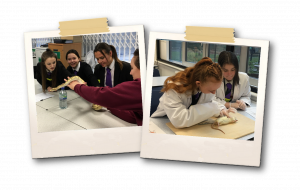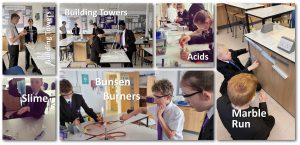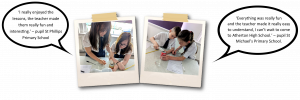Science
“Science and everyday life cannot and should not be separated” – Rosalind Franklin
Intent: The Big Ideas in Science at Atherton High School
In science we aim to foster an enquiring mind and provide students with the skills needed to understand the world around them. We cannot predict what the future will bring for our pupils, but the curriculum is designed to teach pupils to evaluate evidence, form reasoned opinions based on evidence and make informed ethical decisions that are becoming ever more prevalent in today’s technological world. Whatever the future dictates in the lifetime of our pupils, whether it be climate change, genetic technologies, immunology, artificial intelligence, or some, as yet, unknown scientific concern, the skills and understanding developed through our science curriculum will provide a solid base for our pupils to evaluate evidence and provide solutions.
The design of the science curriculum follows the National Curriculum for KS3 and KS4. It is taught through the development of 5 Big Ideas:
- Cells – to know the structure and function of cells, tissues and organs, and how they work together in an organ system.
- Interdependence – to know how the distribution and abundance of organisms can affected in an ecosystem.
- Matter – to understand how the properties of a substance are affected by the structure and arrangement of the atoms that make up the elements and compounds, and how they interact during reactions.
- Energy – to understand how energy flows through a system and how energy can be quantified and calculated.
- Forces – to know how forces can affect the shape, speed and direction of an object and relate these to Newton’s 3 Laws of Motion.
How the Science curriculum contributes to the school’s curriculum intent:
Our curriculum supports students from all backgrounds, including those who are disadvantaged, so students can access a high-quality, knowledge-rich curriculum. Our school community believes strongly in providing disadvantaged pupils with a curriculum that enables them to reach the academic standards of their non-disadvantaged peers. Our goal is to bring our young people into the big conversations of our disciplines, to bring depth to our curriculum, so they can understand the world around them.
- Knowledge – Knowledge is at the heart of every scheme of learning and is developed through key scientific concepts and investigation skills in a mixture of practical investigations, problem solving, worked examples and discussions. Knowledge about key scientific ideas: Cells, interdependence, Particles, Energy and Forces.
- Vocabulary rich – We have selected a challenging list of vocabulary, to enrich learning and deepen subject understanding through exposure to subject specific vocabulary to describe the processes and structures within key concepts in Biology Chemistry and Physics.
- Aspiration – Through a knowledge rich ambitious curriculum pupils are taught challenging subject matter with a focus on developments in science over time and how scientists work to develop solutions to ongoing medical, industrial and environmental concerns. The science curriculum build in the development of critical thinking by challenging pupils perceptions of science, giving then the knowledge and understanding to answer the Big Questions and consider the impact a future scientist can have on our daily lives. Formative feedback is used to support the culture of improvement – we always can improve our work, knowledge and learning.
- Character building – In science we aim to build character through the study and investigation of scientific ideas, which encourage critical thinking and understanding of how scientific ideas and theories become accepted. Resilience & mental toughness are nurtured through the climate for learning in the Science classroom: can do culture, learning from mistakes, DIRT time & meta-cognition. Pupils are also given exposure to a range of careers in science and cultural capital visits including The Big Bang Fair, Chester Zoo, Wigan and Leigh College’s Vets in Practice course and more recently a cultural visit to London to visit the Science Museum and Natural History Museum.
- Love learning – Pupils study engaging, real life themes which encourages students to question and evaluate data and evidence. Teaching methods use a range of techniques to engage pupils and foster a love of learning. Challenge is promoted through deep learning to develop pride in achievement that develops confidence, self-belief and aspiration to learn more.
The Science Learning Journey
Science Knowledge Organisers
Autumn Term
Spring Term
Summer Term
Reading in Science
In Science pupils are taught how to ‘Speak like a Scientist’ through the development of scientific oracy skills. Pupils are taught a wide range of subject specific tier 3 vocabulary, allowing them to articulate the science content with confidence. Pupils are also taught the structure and format of writing scientific reports and the importance of clear concise instructions to carry out methods. They also develop the skills required to analyse and evaluate data collected from scientific investigations.
Learning Beyond the Classroom in Science
We have recently developed a link with Chester Zoo that provides an opportunity for pupils to understand the impact of Climate Change on the biodiversity of our planet. The programme involves in class workshop sessions with specialists from Chester Zoo, followed by a visit to the Zoo to see some of these animals up close.
Pupils also take part in Wigan and Leigh College’s ‘Go Beyond’ off and attend the Vets in Practice classes, where students learn about animal anatomy and care to provide pupils will a range of potential careers this area of science can lead to. As part of the enrichment offer here at Atherton High School, pupils can get involved with the weekly STEM club. Through regular exposure to STEM challenges and activities, pupils are given the opportunity to explore the diverse range of careers that STEM subjects can lead to.
As part of the enrichment offer here at Atherton High School, pupils can get involved with the weekly STEM club. Through regular exposure to STEM challenges and activities, pupils are given the opportunity to explore the diverse range of careers that STEM subjects can lead to.
As part of this STEM offer, Year 7 pupils enjoy the annual Big Bang Fair in Birmingham. This is an exciting opportunity for pupils to immerse themselves in STEM, by experiencing hands-on activities, careers panels and incredible live shows that leave them on the edge of their seats.
Let’s not forget our Year 6 pupils! In conjunction with the feeder primary school, year 6 pupils enjoy the opportunity to ‘Work like a Scientist’. Specialist teachers from the Science Department go into the primary schools to teach a series of lessons that enables the pupils to build their confidence in planning, obtaining analysing and evaluating investigations in a real-world context. Pupils experience a mix of classroom led activities and then join us at Atherton High School to.








